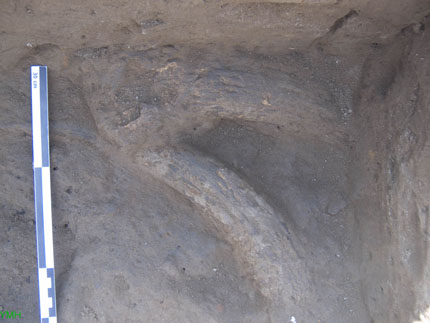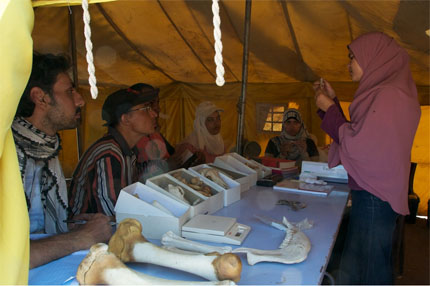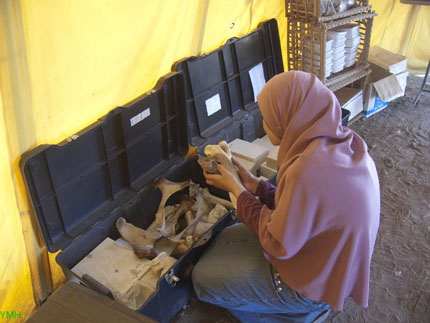Posted by Rasha Nasr, Zoo-archaeologist, SCA
Archaeozoology is the study of animal remains, animal related artifacts and animal related features. The study of animal bones is important because it answers questions about the past, like who, when, what and the important question is why. It can tell us about the economy and the social structure in the past.
Last year, I applied in the field school to study archaeozoology and I was very lucky because I was the first student in that field. I trained with Dr. Richard Redding, AERA archaeozoologist. He taught me how to study animal bones and what to do with the information after identifying bones. We should excavate the fauna carefully and keep accurate records of all the data (include area code, square, feature number, bag number, date and excavator name).

As for the steps of animal bones study, as Dr. Richard taught me, I wash the bones and allow them to dry for a few hours in the shade before removal because damp bones break easily. Then I sorted them into three piles; fish, bird and mammal, followed by sorting each pile into identifiable and unidentifiable fragments. I depend on the comparative collection in my work to identify bones. The comparative collection is a group of modern skeletons that I use to compare with the archaeological fauna. Dr. Richard prepares and increases the comparative collection by bringing animals like fish from the fish market, de-fleshing them and then he puts them in a box with insects (flesh eating beetles) for some months and finally he washes them.
Dr. Richard always says to me no one ever knows everything. So when I found difficult bones, I put them in a bag and made sure to write down all the data on that bag, and would ask Dr. Richard to identify them. This happened this season in Kom El Fakhry. We face a problem in our work here as we cannot identify bird bones because we do not have a comparative collection for the bird, so we put the bird bones in a bag with their data for later study.

Animal bone class in the ‘lab’. Photo by Mark Lehner
In the MRFS 2011, I combined teaching and analysing material. It was very difficult because it was my first teaching experience and teaching takes a long time. I took a group (5 students) for 3 lab sessions of 3 hours each week for 4 weeks. Also I have a lot of faunal remains from this excavation which I have to do. So I tried to work hard because I like my work too much and I was interested in teaching the Beginner’s course. Dr. Richard helped me in the teaching course and he is still helping me in the fauna identification. Because we do not have enough time to do the whole site sample, we decided to work on the priority features to save the time.
In the teaching course, I taught the students how to tell the differences between fish, birds, and mammals. The pectoral spine differences between Clarias, Bagrus and Synodontis. I also talked about mammals’ skeleton. I told the students how to use the comparative collection, then I placed archaeological bones on one table and comparative material on another. I asked them to match the archaeological specimen to the element from the comparative collection. I let them work as a group. Then I talked about tooth eruption and bone fusion and how it can be used to age the animals. I showed them how to tell the sex from the pelvis (illio-pectineal eminence). Then I talked about mammal teeth (carnivore, herbivore, and omnivore). I did some exercises for the students after each session to be sure that they understood what I explained to them. I think the most difficult aspect of the course for the students is the scientific (Latin) names because they do not have enough time to memorize them. The most surprising for them is how much one can tell from animal bones, how one can determine sex and age of the animals and existence of pigs in ancient Egypt.

In fact, it is a good opportunity for me to work in this project especially with Dr. Richard Redding, my teacher, who helped me and is still helping me to this moment.
